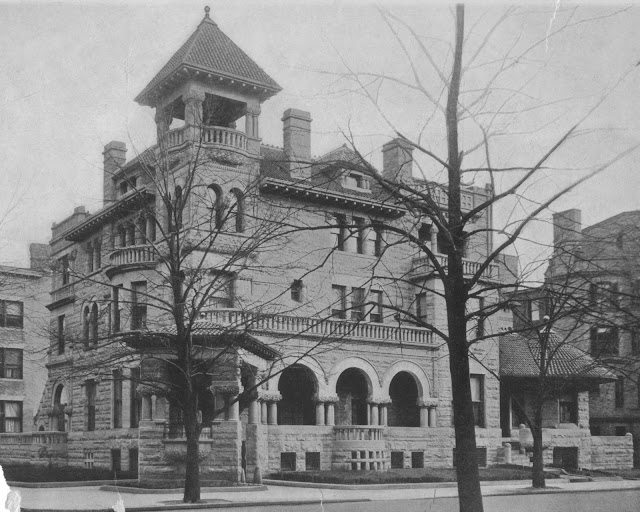 |
| Copyright Sharon Holdren |
The large and
impressive stone house seen here once stood proudly on the south-east corner of
18th and Q Streets. Many readers may recognize it as the Schneider mansion,
home to prolific architect and developer Thomas Franklin Schneider (left) and his family.
He built the house in 1891, only eight years after he began a private practice commonly
designing and building entire blocks of lavish townhouses at once, such the 1700
block of Q Street adjacent the house.
 |
| The Q Street side of the mansion, with rear yard |
What many readers may
not know, however, is that Schneider and his family did not remain in the house
for long. They apparently decided that the house was too large, and possibly
too expensive to staff and maintain following an economic depression in 1893,
and moved not long after its completion into a luxurious apartment in the Cairo
Apartment Building in the 1600 block of Q Street, another Schneider landmark
that would remain in the family until the 1960s. The mansion was
immediately rented to the Chinese legation for a short period, then to Senator
John Fairfield Dryden of New Jersey, and in 1914 to the Colonial School for
Girls. The school had moved into the Schneider mansion from 1715 & 1725-29 Connecticut
Avenue, where Miss Charlotte Crittenden Everett served as principal.
 |
| Outdoor athletics, 1914 |
The school was many
things; both day students and boarding options mixed with college preparatory
classes and finishing school seminars and training. According to its 1915-
 |
| The dining Room, as seen in 1914, set for students |
1916 bulletin, the
“true aim of education is to teach the individual to see clearly, to think independently, to
imagine vividly, and to will nobly.” It noted that its location was “high and
healthful” being just a block from Dupont Circle “in one of the best
residential parts of the city.” The
shopping district and a plethora of street car lines were also highlighted in
the school’s brochure. Meals were served in the dining room, where the mid-day
luncheon only consisted of “milk, bouillon, and crackers.” The girls listened
to evening lectures on such subjects as Moorish art and architecture, the
Panama Canal tolls controversy, and The Effect of War on Womanhood by Jane
Addams.
 |
| Romeo & Juliet performed in the ballroom in March, 1914 |
Thomas Schneider
remained so close to the operation of the school that he invited all the
students to attend the wedding of one of his daughters. Much of the mansion retained the furnishings
of the Schneiders, and rented along with the house. The girls rooms were likely
to each have an open fireplace “for cheerfulness, and for healthfulness.”
Classrooms, study halls, dining room, music studio, laboratory, offices, and
several social gathering rooms completed the lavish environment.
The house also
featured a large rear lawn along Q Street that was utilized for outdoor exercises. Tuition
ranged from $800 to $1,000 per year, with incidental charges for such items as
riding lessons, piano, breaking furniture, “corrective work in gymnastics,” and
sewing. When not attending classes in
Latin, Greek, French and German, home training was taught as an “essential
factor of an education which aids a girl to develop into a wise, true woman.”
The school’s bulletin also stated, “The principal and her associates aim to
help the girls realize the dignity and beauty of presiding in their homes with ease
and graciousness.” History, art, rhetoric, biology, zoology, chemistry,
economics, botany and “the Art of Church Organ” were also available.
 Art students
regularly visited the local galleries, including Veerhoff’s, then located farther
downtown before its eventual relocation to Dupont Circle where it remained until
the mid-1990s; however, all students were closely chaperoned any time they were
off campus: “Under no circumstances are our pupils subjected to the embarrassment
of appearing in public places unchaperoned” reads the school bulletin for 1915.
Art students
regularly visited the local galleries, including Veerhoff’s, then located farther
downtown before its eventual relocation to Dupont Circle where it remained until
the mid-1990s; however, all students were closely chaperoned any time they were
off campus: “Under no circumstances are our pupils subjected to the embarrassment
of appearing in public places unchaperoned” reads the school bulletin for 1915.
Students were charged
50 cents an hour when visiting doctors or dentists. Principal Everett was joined by co-principal
Jessie Truman in 1920, and the school continued to operate in the Schneider mansion
until 1930, when the house was converted into a boardinghouse. Twenty-eight years later,
the house was razed for a parking lot. In 1961, the nine story Dupont East
apartment building was built on its site, and remains there today (illustrated below).


1 comment:
Terrific article. Thanks.
Post a Comment